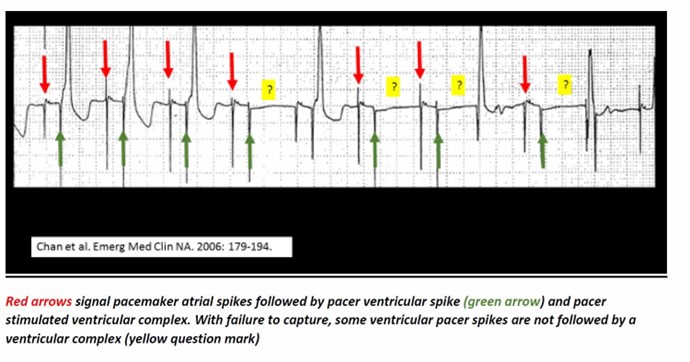A nurse is monitoring a client's heart rhythm following the insertion of a permanent pacemaker.
Which of the following images should the nurse expect?
A regular sinus rhythm.
A chaotic, irregular rhythm.
Absence of any electrical activity.
A series of spikes followed by a QRS complex.
The Correct Answer is D

A pacemaker sends electrical signals to the heart to regulate the heartbeat.
On an electrocardiogram (ECG), these signals appear as small spikes followed by a QRS complex, which represents the contraction of the ventricles.
Choice A, A regular sinus rhythm, is not the correct answer because a regular sinus rhythm is a normal heart rhythm that originates from the sinoatrial (SA) node and does not involve a pacemaker.
Choice B, A chaotic, irregular rhythm, is not the correct answer because a pacemaker is designed to regulate the heartbeat and prevent chaotic or irregular rhythms.
Choice C, the Absence of any electrical activity, is not the correct answer because a pacemaker sends electrical signals to the heart to regulate its activity.
Nursing Test Bank
Naxlex Comprehensive Predictor Exams
Related Questions
Correct Answer is D
Explanation

A pacemaker sends electrical signals to the heart to regulate the heartbeat.
On an electrocardiogram (ECG), these signals appear as small spikes followed by a QRS complex, which represents the contraction of the ventricles.
Choice A, A regular sinus rhythm, is not the correct answer because a regular sinus rhythm is a normal heart rhythm that originates from the sinoatrial (SA) node and does not involve a pacemaker.
Choice B, A chaotic, irregular rhythm, is not the correct answer because a pacemaker is designed to regulate the heartbeat and prevent chaotic or irregular rhythms.
Choice C, the Absence of any electrical activity, is not the correct answer because a pacemaker sends electrical signals to the heart to regulate its activity.
Correct Answer is C
Explanation
The nurse should plan to notify the Rapid Response Team first.
The client’s blood pressure is elevated, heart rate is high, respiratory rate is high, and oxygen saturation is low.
These are all signs of potential instability and the Rapid Response Team should be notified immediately.
Choice A is incorrect because while obtaining an ECG may be important, it is not the nurse’s first priority in this situation.
Choice B is incorrect because while calculating the extent of burns using the rule of nines may be important, it is not the nurse’s first priority in this situation.
Choice D is incorrect because while initiating peripheral IV access may be important, it is not the nurse’s first priority in this situation.
Whether you are a student looking to ace your exams or a practicing nurse seeking to enhance your expertise , our nursing education contents will empower you with the confidence and competence to make a difference in the lives of patients and become a respected leader in the healthcare field.
Visit Naxlex, invest in your future and unlock endless possibilities with our unparalleled nursing education contents today
Report Wrong Answer on the Current Question
Do you disagree with the answer? If yes, what is your expected answer? Explain.
Kindly be descriptive with the issue you are facing.
